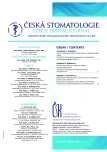Review of the Expert Systems in General Medicine and Dentistry
(Review Article)
Authors:
E. Šedivá; L. Hart; T. Dostálová
Authors‘ workplace:
Stomatologická klinika dětí a dospělých 2. LF UK a FNM, Praha
Published in:
Česká stomatologie / Praktické zubní lékařství, ročník 117, 2017, 1, s. 3-7
Category:
Review Article
Overview
The aim of Study:
Development of expert systems (ES) has been going on for over 45 years and in the course of time gradually evolving, changing the face and appears in its use across our company. Expert systems from the 70s gradually expanded primarily in medical informatics, which in recent years is growing in importance, especially for high structuring of medical knowledge. The aim of expert systems to solve the situation in the absence of an expert – a man. The human expert but is absolutely essential cell during development, since he defines their knowledge base (knowledge base), without which the ES could not decide alone. Hence their inclusion among the so-called next Programs to support medical decisions – „Decision Support Systems“.
Among the most famous expert systems include general medicine DENDRAL (it was the first expert system in the initial development and today it is used), as well as MYCIN (was designed to quickly identify the type of bacterial infection and suggest appropriate treatment with antibiotics), PUFF, ONCOCIN (was designed to manage patient treatment Cancer Care unit), INTERNIST-1 (is among one of the largest ever expert systems in history, his role was to cover the entire area of knowledge of internal medicine, a modification was renamed the caduceus). Part of these expert systems are already in practice is not used, but their modification of the ES function in new ES.
Conclusion:
The use of expert systems in the field of dentistry has, unfortunately, such as history in general medicine and is at the very beginning, but new systems that are beginning to produce or yet to be developed, drawing on the foundations of a modification of the older expert systems.
Keywords:
expert system – knowledge – based system – inference mechanism – evidence-based medicine – DENDRAL – decision support system
Sources
1. Aikins, J. S., Kunz, J. C., Shortliffe, E. H. , Fallat R. J.: An expert system for interpretation of pulmonary function data. Computers Biomedical Res., roč. 16, 1983, s.199–208.
2. Berka, P.: Expertní systémy. Praha, Vysoká škola ekonomická, 1998, 160 s. ISBN 80-7079-873-4.
3. Feigenbaum, E. A., Buchanan, B. G., Ledeberg, J.: On generality and problem solving: a case study Usány DENDRAL Program. In: Meltzer, B., Michle, D. (eds.), Machina Inteligence 6. Edinburgh University Press, Edinburgh, 1971, Edinburgh University Press, 1971. 165–190 s. ISBN10: 085224195X ISBN 13: 9780852241950.
4. Feigenbaum, E. A. The art of artificial intelligence: I. Themes and case studies of knowledge engineering, in Proc. IJCAI-77, Cambridge, 1977, s. 1014–1029.
5. Feigenbaum, E. A., McCorduck, P., Penny Nii, H.: The rise of the expert company: how visionary companies are using artificial intelligence to achieve higher productivity and profits. New York, Times Books, 1988, ISBN 10: 0812917316 ISBN 13: 9780812917314.
6. Giarratano, J. C., Riley, G.: Expert system – principles and programming. 3rd ed., PWS Publishing, Boston, MA, 1998, 288 s. ISBN-10: 0534384471.
7. Goldstein, I. P., Pápery, S.: Artificial inteligence, language and the study of knowledge. Cognitive Science, roč. 1, 1977, s. 1–21.
8. Gates-Roth, F., Waterman, D. A., Lenat, D. B.: Building Expert System. Reading, Massachusetts. Addison-Wesley Publishing Company, Inc., 1983, s. 3–29. ISSN: 0950-7051.
9. Hippmann, R., Dostálová, T., Zvárová, J., Nagy, M., Seydlova, M., Hanzlícek, P., Kriz, P., Smidl, L., Trmal, J.: Voice supported health rekord for temporomanidular point disorders. Methods Inf. Med., roč. 49, 2010, č. 2, s. 168–172.
10. Kasal, P., Svačina Š.: Lékařská informatika. Praha, Karolinum, 1998.
11. Mahdian, N., Dostalova, T., Feberová, J., Hubáček, M.: Možnosti využití expertního systému v diagnostice čelistních cyst. Čes. Stomat., roč. 113, 2013, č. 4, s. 52–56.
12. Mařík, V., Štěpánková, O., Lažanský, J.: Umělá inteligence 1. 1. vyd. Praha, Academia, 1993. 264 s. ISBN 80-200-0496-3.
13. Mařík, V., Štěpánková, O., Lažanský, J.: Umělá inteligence 2. 1. vyd. Praha, Academia, 1997. 373 s. ISBN 80-200-0504-8.
14. Miller, R. A., Pople, H. E., Meyers, J. D.: INTERNIST-l, an experimental computer-based diagnostic consultant for general internal medicine. NEJM, roč. 307, 1982, č. 8, s. 468–476.
15. Minsky, M.: Computation, finite and infinite machines. Prentice-Hall, Engelwood Cliffs, 1967, s. 317. ISBN-13: 978-0131655638.
16. Robertson, A., Noren, J. G.: Knowledge-based systém for structured examination, diagnosis and therapy in treatment of traumatised teeth. Dent. Traumatol., roč. 17, 2001 č.1, s. 5–9.
17. Sackett, W. M. C., Rosenberg, J. A. M., Gray, R. B., Haynes, W., Richardson, S. Evidence based medicine: what it is and what it isn‘t. BMJ, roč. 312, 1996, č. 7023, s. 71–72.
Labels
Maxillofacial surgery Orthodontics Dental medicineArticle was published in
Czech Dental Journal

2017 Issue 1
Most read in this issue
- Biochemical Composition of the Teeth and the Effect of the Various Chemical Elements on their Structure (Review article)
- The Effect of Chemical Compounds on Pigmentation and Depigmentation of Teeth (Review article)
-
Review of the Expert Systems in General Medicine and Dentistry
(Review Article) - The Roma Population and Selected Aspects of Dental Care (Original Article – Epidemiologic Study)
